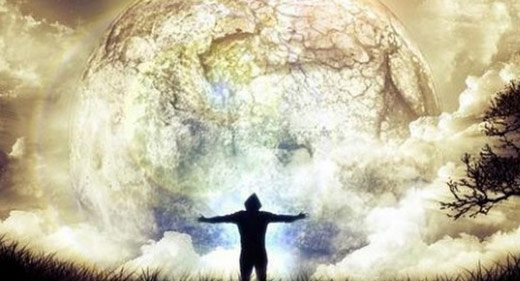Donna Quesada: It’s so simple, but so profound, so if I’m understanding correctly, you’re saying…
if we can make that switch within ourselves, when something… when we feel the world has done us wrong?
Lama Lakshey: Right.
Donna: From victim consciousness to compassion. When I stop feeling like I’m a victim, like they’ve done it to me, and I instead turn it around to it’s better me than someone else because I can deal with this, then I can bear it, I can shoulder it. Then I set myself free, in a sense?
Lama Lakshey: Absolutely, and then we can use that in the true… Oh, someone else, we heard, is going to through similar situation… Me, I really care, and very special, and the feeling and affection towards that person, and they perhaps reach out, share one’s own experiences and then, how I can help. And when we go through some, either physically, mentally, emotionally… some challenges, and if we know that is a going to transform into in the loving care or compassion… and true, in order to… how to reuse that for the benefit—rather than “this is disturbing for me.” And then it becomes, it’s a wisdom, is become awakening and become special. True, in order to give a light for others who are going through that difficult situation.
Therefore, I say yes, absolutely. Like, I sometimes say we have a remote control and we can change any… sure we want, we know how to mentally use that. So therefore, meditations, many of them, is to make us to have the right, and our own mind to things, so they can make a choice. Sometimes we let the disturbing emotions we habituated choose what they are used to. And that’s nothing more… everyone is similar. But if we have some kind of mental, kind of, potential ability and can change that, then it’s really external circumstances… even we thought to change, and it will give a special insight, and that person can change that, so therefore, our mind… to somebody who has that truth, somebody who has that remote control on the end. Yeah, like that.
Donna: I like the remote control analogy. Well, I’ve had a long standing interest in Buddhism for many years, but my personal practice was more in the Japanese Zen lineage, so I’m very interested in your practice along these lines. I believe that in your tradition, in the Tibetan practices, there’s something called Tonglen which specifically requires this switch, where you’re taking away other people’s pain. Am I recalling it correctly?
Lama Lakshey: Yes. Tibetan Buddhism is very rich and the practice in order to train the mind towards the real, very compassionate way, but in the… there’s stages, there’s realization first, in terms of… there’s three things. And diversity, understand. One is Tibetan Buddhism, or Buddhism in general, and the notion of reincarnation, and so in that circle, every sentient being in this life or another life before, and either your father or mother, your brother, sister-in-law, and we all come from a circle, and so therefore, and sometimes realize… like each, every sentient being is able to understand mother kindness is very profound, and the way of everyone, and the giving and the life and for everything. Sometimes I just say, we come from this world. Nothing. We didn’t bring any money…
We didn’t bring even cloth and everything. Really, truly giving the kindness of our parents and the mother’s love, so where we grow up, so when we realize that not only mother, and all those living creatures in one time or another, are our mother, and they are all kind for us in that period of times. Either we remember or not, and we recognize, or not today, but we are come from the circle of life, so therefore, in one time or another, and our parents and our beloved ones, so therefore, is one thing that… then we feel like how I can help… back for all these living beings, and they’re just like my mother. They’re like my loved one.
They’re just like my beloved ones, so therefore, when we see that, then when we have our own situations, or we see somebody else going through some difficulties, and then we wish it to, Oh, I can take like mother, for example, when they sit their beloved child, a baby who was sick, the mothers always think if I can take the baby’s sick right now… To me, many mothers are willing to do that, if they’re able to do that much. They care about that, and so, when we see that, and sometimes the fallen ideas… and a very deep, and our heart, and the deeper our heart thinks about somebody who going into a difficult situation… I wish I can take that and, May you be free from the suffering… And sincerely, that is not just like a prayer, but it’s like someone, our beloved one is going through a difficult situation, and like that we think.
Then sometimes there’s courage, and force the courage rising… Oh, if I am able to suffer that, if I can take their suffering… and because I think I can do that, like that kind of arising, and then we think about, I wish to free you from the suffering or may you free from that suffering, and then it’s taking that. Then also, when we see our happiness, our relaxation, our physical, mental comfort, whatever, we have all virtuous, and familiarization, and then we visualize that somebody who doesn’t have that, and then sincerely you can wish to give that, you can transform somebody… so they won’t lack happiness, lack wealth, and whatever that person is going through, in some difficult situations.
When you have the other oppositions like happiness, joy and comfort, or good possession or wealth, whatever… that wishes mentally… you can give that to that person, and then free that person from their suffering. So therefore, there is compassion, love and kindness. One is we think about work, love, and can wish you too, to be happy, for others, and to wish others to be free… for happiness, to provide happiness. Compassion is wishing for others to be free from their suffering, so therefore, one is a giver.
When you mean… when you are “giving” to those… and the individuals or the living beings… to give their happiness… you wish, and the prayer to obtain the happiness, and not just temporary, last-long happiness, as much as possible… depends on our mentor training, and then receiving their suffering. And free those individuals from their suffering, and say, take one person as a representative, their suffering, and all that is their suffering, I take my happiness to give them, and that’s a really interesting practice… notion… because in our human habit, we only focus as,
Oh, when suffering comes… we don’t think that… we think about how we… What am I suffering from and How can I find happiness.
We are very much engaged with “I,” and not them or they or you, and so therefore, if this kind of exchange that gives us… encourages us to face with difficult situations, and when the difficult situations arise, then we will not be that much disturbed because we will have this, kind of, a mental strength, in order to face that challenge. And we’ll have a technique in order to overcome that, so it’s some kind ofindividual build there, and a mental strength in order to face with the challenges and then become greater in our practice to be compassionate beings. And when we become individually compassionate, then we will have a special interconnection with other people and then eventually, perhaps, it will provide us with more energy of the compassionate attitude towards others.
I think it’s a very powerful practice, but it is not simple. We can talk about everything, but some sort of the idea… and Tonglen is very powerful in the practice. Special, special healing in the people who have traumas in the difficult situation they experience from the past. If those people were able to practice Tonglen, I think we could heal the traumas, and so yeah, and it’s a very powerful practice.
Donna: Lama Lakshey, I love what you said about having a technique that’s really usable, right here, right now, and so many people deal with everyday sufferings… they’re angry. It’s something that happened at work or something that happened with their parents or their children, and it might be a longstanding grudge or just a temporary aggravation, and I love that we can make this so useful, rather than philosophical. Would you be willing to share a meditation or a technique, that someone can use on the spot when they feel angry, for example, or when someone has done them wrong?
Lama Lakshey: Yes, and here, for example, when we look, when we are angry, we always think we have a right to be angry. Yes, you… everyone has a right to be angry as long as the benefit is something very useful… if the anger could make us more productive or more purposeful, but when we look at the truth, when we look, and anger is not really bringing up… what if we use the common sense and the logic of our brain: Anger is not making us happier or healthier or more peaceful. The quality of anger is some sort of destroying, and destroying not for others’ life, destroying our own life and destroying our own peace of mind, so therefore… and the first is important to acknowledge and realize about the quality of anger.
Anger is kind of kept “to stick.” Then when we look at that, and that one is the Buddhist one, in the study of Maya, traditional study, and when we look at… when I’m angry, the anger itself is like some kind of, it’s not an independent characteristic. Anger, doesn’t have its own solid. It is kind of permanent. Anger is also very conditional… and has a lot of factors in order to arise.
Then the one aspect, when we meditate, is to look, and it is a little bit like observing what anger comes from… or, Yes, that person makes me really difficult and sad… and physically, whatever that happened, and tortured, and Oh, that person… When we think, but if our logic mind… if we use that person, it is also very conditional, in itself.
Our number one, and utterly, our disturbing causes… In order to be angry, there’s cause and conditions, and one is the cause. And normally, we can think about our outside. Outside is the main causes because that person, that one who makes me in this situation, and then it’s constantly we apply that we anger to that person, but then we can little bit relax and the meditation, that person is where I’m particularly angry… that person. And that person’s like physical, or the head or nose or even part of anything, and that person has many… and that’s when we look at one person, this bad person… sometimes we say, “Because he did that to me.” But then, you really think that person is usually the way of a human mind… you think, he’s tired, that person’s really bad because he did the bad thing to me.
Then we think about that, then we only see the total like a block, and Oh, that’s bad. That’s all we see, but if we let our mind explore a little bit, that person, because someone else said that person’s good… because it’s my father, my brother, my sister, my cousin, my mom, my dad or something. Many other people see that that person’s good… many goodness in that person, so that person’s not necessarily entirely bad. There’s also goodness, and also that person himself is a lot in the conditions they’re living with, so therefore, not necessarily… we needed to see that. So, when we see the big holistic view towards the person, then the person is not the real cause of our mental disturbance or the anger.
Then when we look at ourselves, and that’s one very Vajrayana Buddhist study, and the monster is exploring our own mind. The anger does not have necessarily, a color or shape or form. Something we can find is tangible from outside, so therefore, when exploring ourselves inside, and then our under world and then we look in our own mind, what’s the anger? What’s the color or shape? Where is the location? Where does it exist? Sometimes when we do that meditation, when we are looking through, we close our eyes when I’m….
Donna: You do that for a few minutes?
Lama Lakshey: Yes, yes. With the talk, without talk. With the talk… right?
Donna: Like a little guided meditation?
Lama Lakshey: Yes, so here, and first important, find a comfortable seating, always very important… our physically… and find a really comfortable sitting. Then relax, take a deep breath, a couple long deep breaths, let it release, our physical tiredness and mental time, and then just a couple of deep breaths… enjoy the breath and then realize the breath and breathing’s present. There’s nothing happening… not to some sort of repeat and past, our collective memories and noting, or speculation for future plans… just to be experienced in the present and the experience of the present, and the breathing and the coming of cooler air, warm air coming out, so like that, and then our mind is calm, relaxed, and then start.
What is the most bothered in our heart, in our mind, and then there’s some anger, some kind of hatred or some kind of regret or disappointment, or resentment, whatever, and bring that, and then watch that, look where it is in your heart, in your brain. If that is what you think in your brain, then where, in the back and front… which side is there? Is there any color or shape? When we look at that, then don’t find any particular, any part of when the burn tissues or in the neurons, and then we come back into our heart and somewhere in the heart, and then the same… look at all the locations, places, and then you can’t necessarily find anything… that’s a very good thing, and there’s no real interchangeable type of of anger that’s really disturbing you, and that needs some kind of mental imprint.
Therefore, it is when you go to deeper, that imprints something, you can let it go or something is really solid. When you look at that, then you go to deeper for the anger. There’s no reason to hold as tightly to that anger because there’s no really tangible shape or form. Even there’s no color! Rather some sort of memory, or mental fabrication… So therefore, try to let go of that, and like you, almost like flying in space, you fly in the space, you’re not imprinting anything in the space, just you fly and everything kind of disappears after you fly, like all the thoughts… and it calms and it goes… does not imprint… and you’re not holding any grudge.
Just let it go, and totally… when you’re discovering there’s no location, no characteristic of form or shape, then relax, and then when you release yourself from the sadness of the hold and the kind of the anger when it’s gone, and then what you feel, you feel very released, you find truly freedom from disturbance. That’s very enjoyable. Freedom is peace. Freedom is tranquility, very enjoyable, very clear, like you are yourself… the highest mountain Everest in the top, or fly in the sky. Just enjoy and slowly come back. All anger is just illusion. Does not really exist. And other than my, some sort of clinging to, or grasping towards that, and I can let it go. When it is let go of, I feel myself is free from it, and that gives me… encourages a better living, a more productive life, peace, and also, I can influence a better life for others and for my own sake and for others.
I let go the anger. Anger is just illusion. It’s a mental imprint, it’s not really existing anywhere else, other than it’s in the mental imprint, so therefore, a little bit of luck in the mind—that is our consciousness… it’s very, kind of, fancy, it’s very pure. Like, our mind is interesting, and like, anger is the seclusion and the water. When you let out all the pollution from the water, the water is very pure, very pristine, very clear, very calm. The water sometimes looks to move because of the conditions. Sometimes the ocean has a lot of waves because there’s wind and the ocean’s salty because of the salt in it, but not the water itself, so when they look and our mind is like in the pure and the water is very clear, very pristine.
When we look at that and then man does not get obscured by this, and disturbed, so they are, kind of, very on-the-surface, like the ocean has many waves and the surface goes a little deeper, and is very calm and very clear. And likewise, our own mind will go on a deeper journey. It’s very calm and is very clear. It’s never obscured by any of our disturbing thoughts, so therefore, disturbing thoughts are just on the surface of our own mind, and then we realize that, then engage with more of who we are, and with our nature.
That will very helpful, and we need to build that more stable, and become more familiarized, and then eventually, in the true conditions of the outside the world, when we have some difficulties come, and then we can still that, and then we realize that that’s the surface of our experiences. If we are able to go to a little bit more deeper in our journey in the like ocean, there’s an “unmoving.” It is very calm and very clear, so like that, that’s a little helpful something.
Read and Watch Part 3 Here: Awaken Interviews Lama Lakshey Zangpo Rinpoche Pt 3 – Personal Peace Is Really the Main Cause of Intra-Personal Peace
Read and Watch Part 1 Here: Awaken Interviews Lama Lakshey Zangpo Rinpoche Pt 1 – Happiness Comes From Contributing To The Wellbeing Of All Life









































